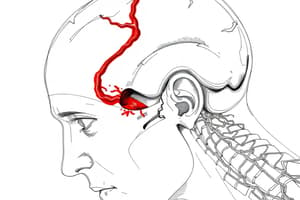Podcast
Questions and Answers
Which components are part of the Revised Trauma Score (RTS)?
Which components are part of the Revised Trauma Score (RTS)?
- Glasgow coma scale (correct)
- Mechanism of Injury
- Respiratory Rate (correct)
- Injury Severity Score
What is the most common type of skull base fracture?
What is the most common type of skull base fracture?
- Posterior cranial fossa fracture
- Anterior cranial fossa fracture (correct)
- Middle cranial fossa fracture
- Frontal lobe contusion
Which factor is NOT part of the Mangled Extremity Severity Score (MESS)?
Which factor is NOT part of the Mangled Extremity Severity Score (MESS)?
- Limb ischemia
- Respiratory Rate (correct)
- Energy that caused the injury
- Age
Which mechanism of injury is considered in calculating the Trauma and Injury Severity Score (TRISS)?
Which mechanism of injury is considered in calculating the Trauma and Injury Severity Score (TRISS)?
What percentage of skull base fractures are classified as posterior cranial fossa fractures?
What percentage of skull base fractures are classified as posterior cranial fossa fractures?
Flashcards are hidden until you start studying
Study Notes
Revised Trauma Score (RTS)
- Composed of Glasgow Coma Scale, Systolic Blood Pressure, and Respiratory Rate.
Trauma and Injury Severity Score (TRISS)
- Comprised of Injury Severity Score (ISS), Revised Trauma Score (RTS), Age, and Mechanism of Injury (Blunt or Penetrating).
Mangled Extremity Severity Score (MESS)
- Considers:
- Energy of the injury
- Limb Ischemia
- Shock
- Age
Skull Base Fracture
- Anterior cranial fossa fracture is the most common, accounting for approximately 70% of cases.
- Middle cranial fossa fractures make up about 20%.
- Posterior cranial fossa fractures are the least common, representing about 5%.
- The frequency of skull base fractures is represented by the following: ACF > MCF > PCF.
- Anterior cranial fossa fractures are primarily associated with frontal bone involvement.
- Middle cranial fossa fractures often lead to temporal lobe contusion.
- Posterior cranial fossa injuries can result in occipital lobe contusion.
Regions of the Skull
- Anterior Fossa: 70%
- Central Skull Base: 25%
- Middle Fossa: 5%
- Posterior Fossa: 5%
Studying That Suits You
Use AI to generate personalized quizzes and flashcards to suit your learning preferences.




